NURS 5159: Case Study on ISBAR Clinical Handover and Analysis
VerifiedAdded on 2023/01/11
|16
|4908
|55
Case Study
AI Summary
This document presents a comprehensive case study focusing on ISBAR clinical handover in mental health nursing. The case involves a 42-year-old female patient exhibiting symptoms of dementia and mood disturbances, and a 44-year-old female with bipolar affective disorder and borderline personality disorder traits. The case study includes detailed patient backgrounds, assessments, and diagnoses. It outlines the patients' situations, backgrounds, assessments, and recommendations for treatment and ongoing care. The ISBAR (Identification, Situation, Background, Assessment, Recommendation) framework is applied to provide a structured approach to clinical handover, covering medication reviews, monitoring, and referral to therapists. The case study also explores behavioral changes, and challenges associated with the conditions, providing insights into effective communication and patient management within the mental health setting. Finally, it also includes the discussion of the case study presentation and coursework contents.
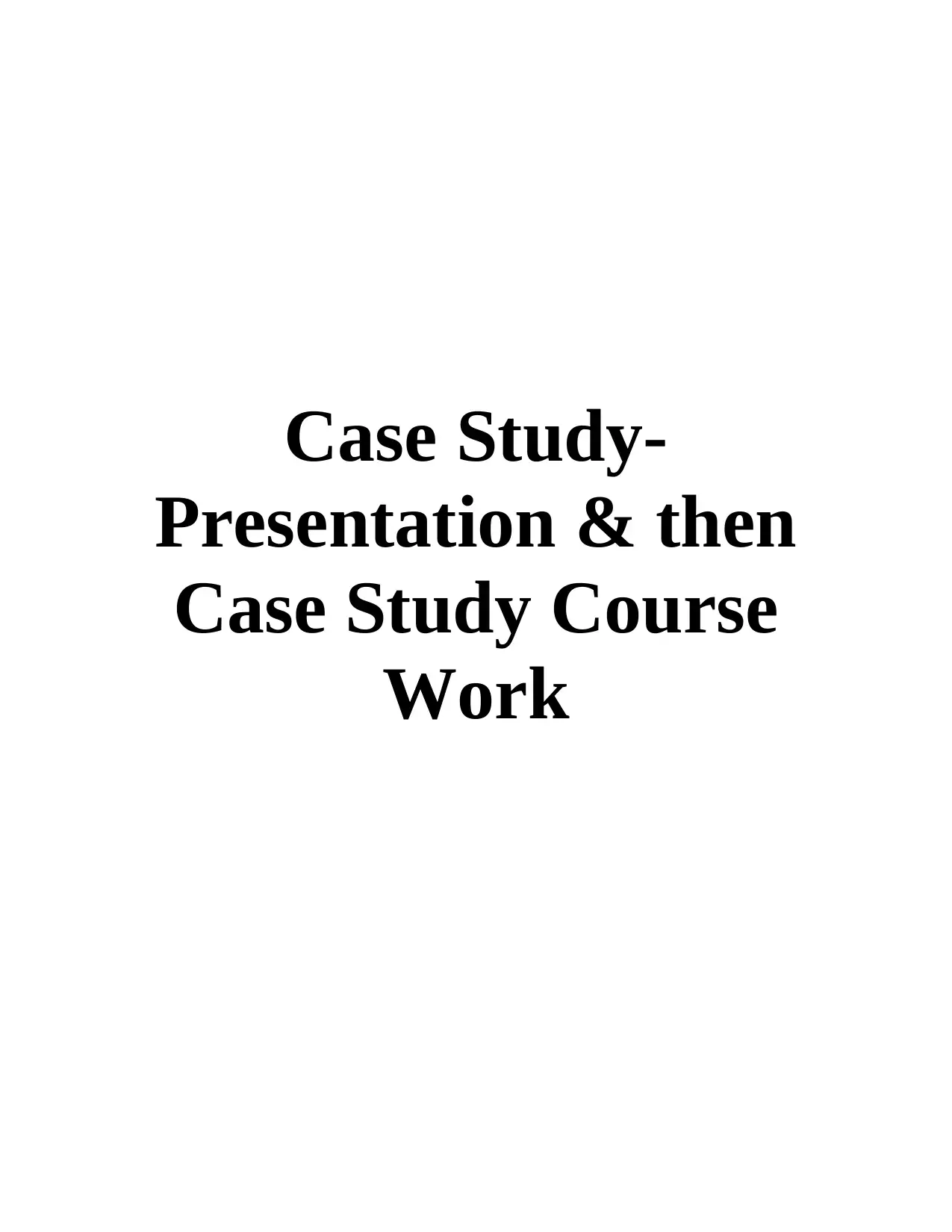
Case Study-
Presentation & then
Case Study Course
Work
Presentation & then
Case Study Course
Work
Paraphrase This Document
Need a fresh take? Get an instant paraphrase of this document with our AI Paraphraser
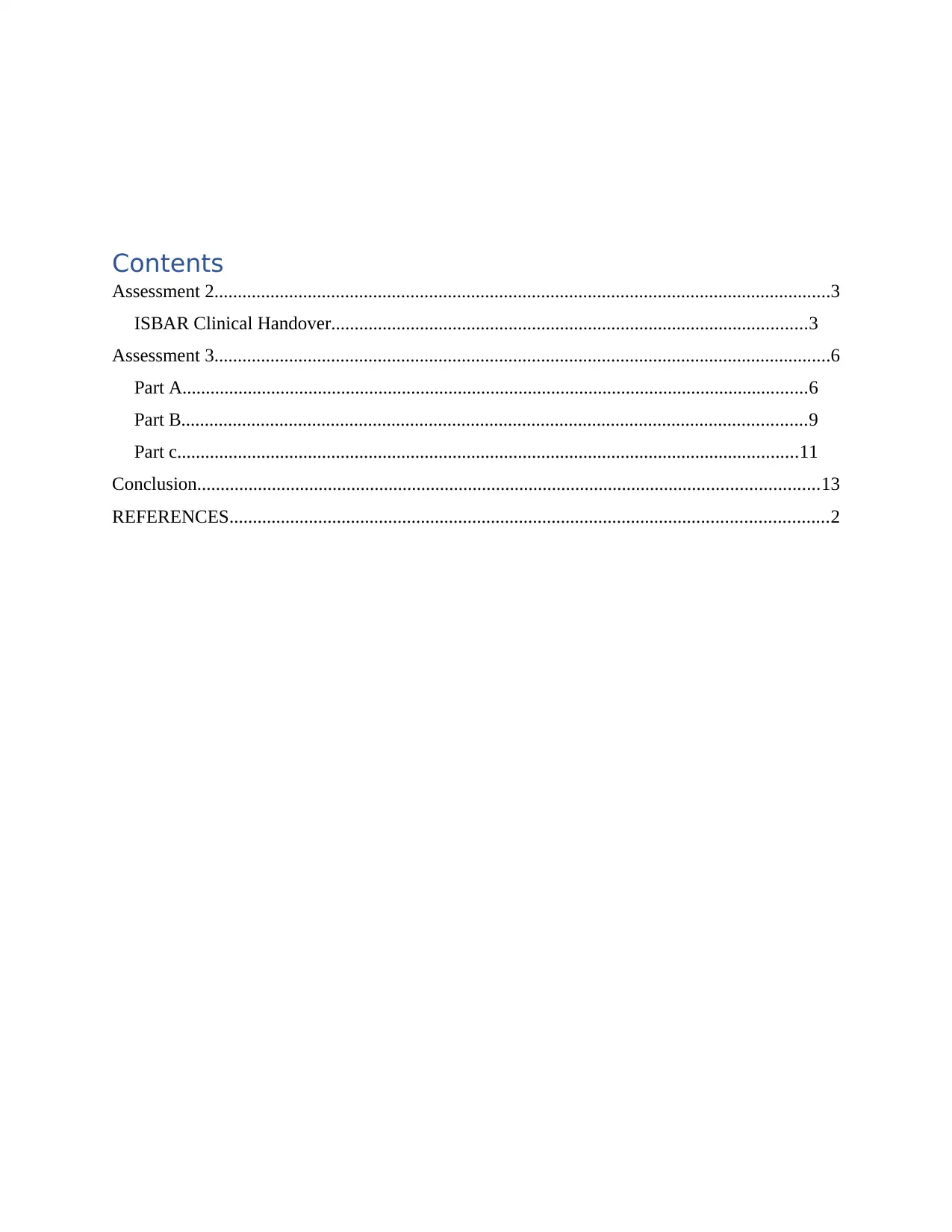
Contents
Assessment 2....................................................................................................................................3
ISBAR Clinical Handover......................................................................................................3
Assessment 3....................................................................................................................................6
Part A......................................................................................................................................6
Part B......................................................................................................................................9
Part c.....................................................................................................................................11
Conclusion.....................................................................................................................................13
REFERENCES................................................................................................................................2
Assessment 2....................................................................................................................................3
ISBAR Clinical Handover......................................................................................................3
Assessment 3....................................................................................................................................6
Part A......................................................................................................................................6
Part B......................................................................................................................................9
Part c.....................................................................................................................................11
Conclusion.....................................................................................................................................13
REFERENCES................................................................................................................................2
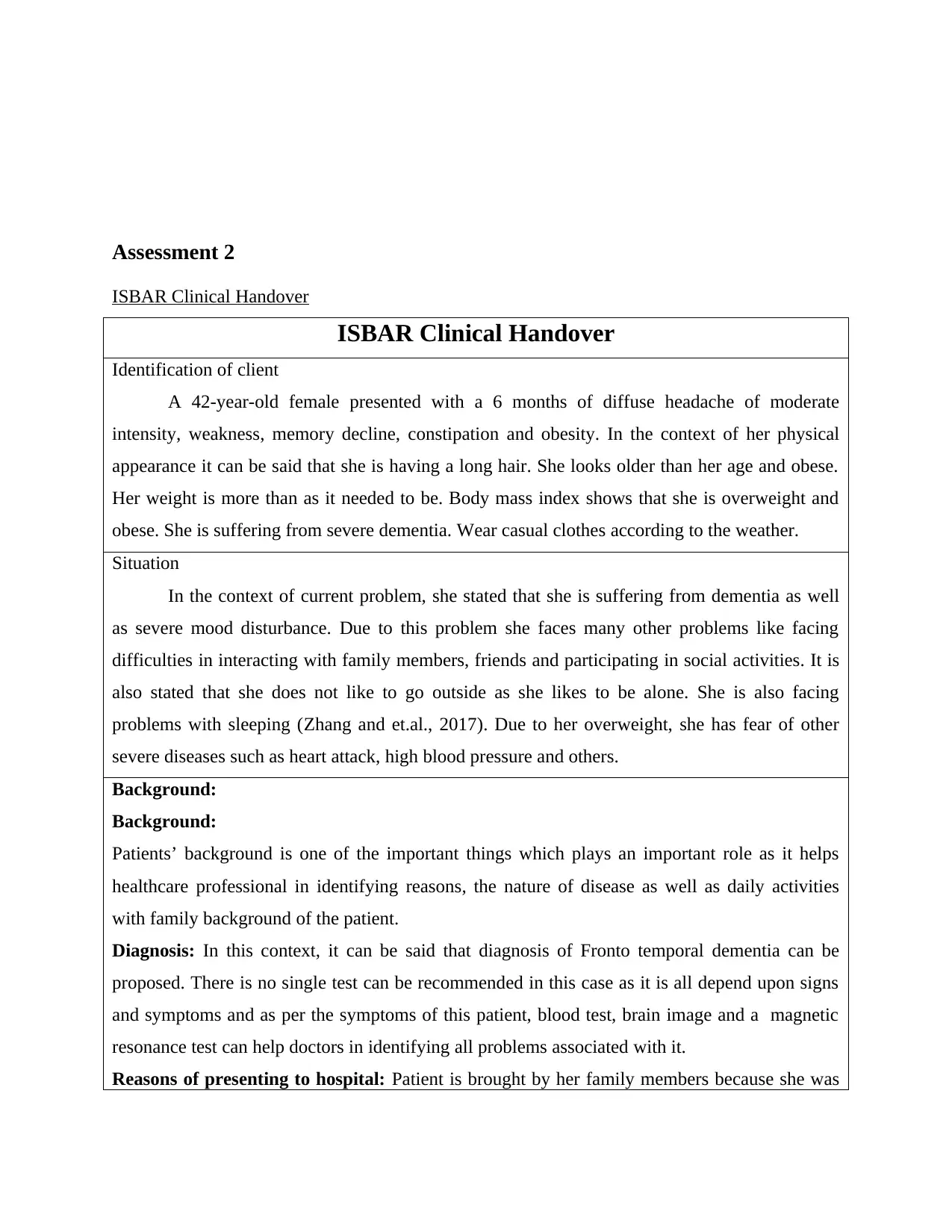
Assessment 2
ISBAR Clinical Handover
ISBAR Clinical Handover
Identification of client
A 42-year-old female presented with a 6 months of diffuse headache of moderate
intensity, weakness, memory decline, constipation and obesity. In the context of her physical
appearance it can be said that she is having a long hair. She looks older than her age and obese.
Her weight is more than as it needed to be. Body mass index shows that she is overweight and
obese. She is suffering from severe dementia. Wear casual clothes according to the weather.
Situation
In the context of current problem, she stated that she is suffering from dementia as well
as severe mood disturbance. Due to this problem she faces many other problems like facing
difficulties in interacting with family members, friends and participating in social activities. It is
also stated that she does not like to go outside as she likes to be alone. She is also facing
problems with sleeping (Zhang and et.al., 2017). Due to her overweight, she has fear of other
severe diseases such as heart attack, high blood pressure and others.
Background:
Background:
Patients’ background is one of the important things which plays an important role as it helps
healthcare professional in identifying reasons, the nature of disease as well as daily activities
with family background of the patient.
Diagnosis: In this context, it can be said that diagnosis of Fronto temporal dementia can be
proposed. There is no single test can be recommended in this case as it is all depend upon signs
and symptoms and as per the symptoms of this patient, blood test, brain image and a magnetic
resonance test can help doctors in identifying all problems associated with it.
Reasons of presenting to hospital: Patient is brought by her family members because she was
ISBAR Clinical Handover
ISBAR Clinical Handover
Identification of client
A 42-year-old female presented with a 6 months of diffuse headache of moderate
intensity, weakness, memory decline, constipation and obesity. In the context of her physical
appearance it can be said that she is having a long hair. She looks older than her age and obese.
Her weight is more than as it needed to be. Body mass index shows that she is overweight and
obese. She is suffering from severe dementia. Wear casual clothes according to the weather.
Situation
In the context of current problem, she stated that she is suffering from dementia as well
as severe mood disturbance. Due to this problem she faces many other problems like facing
difficulties in interacting with family members, friends and participating in social activities. It is
also stated that she does not like to go outside as she likes to be alone. She is also facing
problems with sleeping (Zhang and et.al., 2017). Due to her overweight, she has fear of other
severe diseases such as heart attack, high blood pressure and others.
Background:
Background:
Patients’ background is one of the important things which plays an important role as it helps
healthcare professional in identifying reasons, the nature of disease as well as daily activities
with family background of the patient.
Diagnosis: In this context, it can be said that diagnosis of Fronto temporal dementia can be
proposed. There is no single test can be recommended in this case as it is all depend upon signs
and symptoms and as per the symptoms of this patient, blood test, brain image and a magnetic
resonance test can help doctors in identifying all problems associated with it.
Reasons of presenting to hospital: Patient is brought by her family members because she was
⊘ This is a preview!⊘
Do you want full access?
Subscribe today to unlock all pages.

Trusted by 1+ million students worldwide
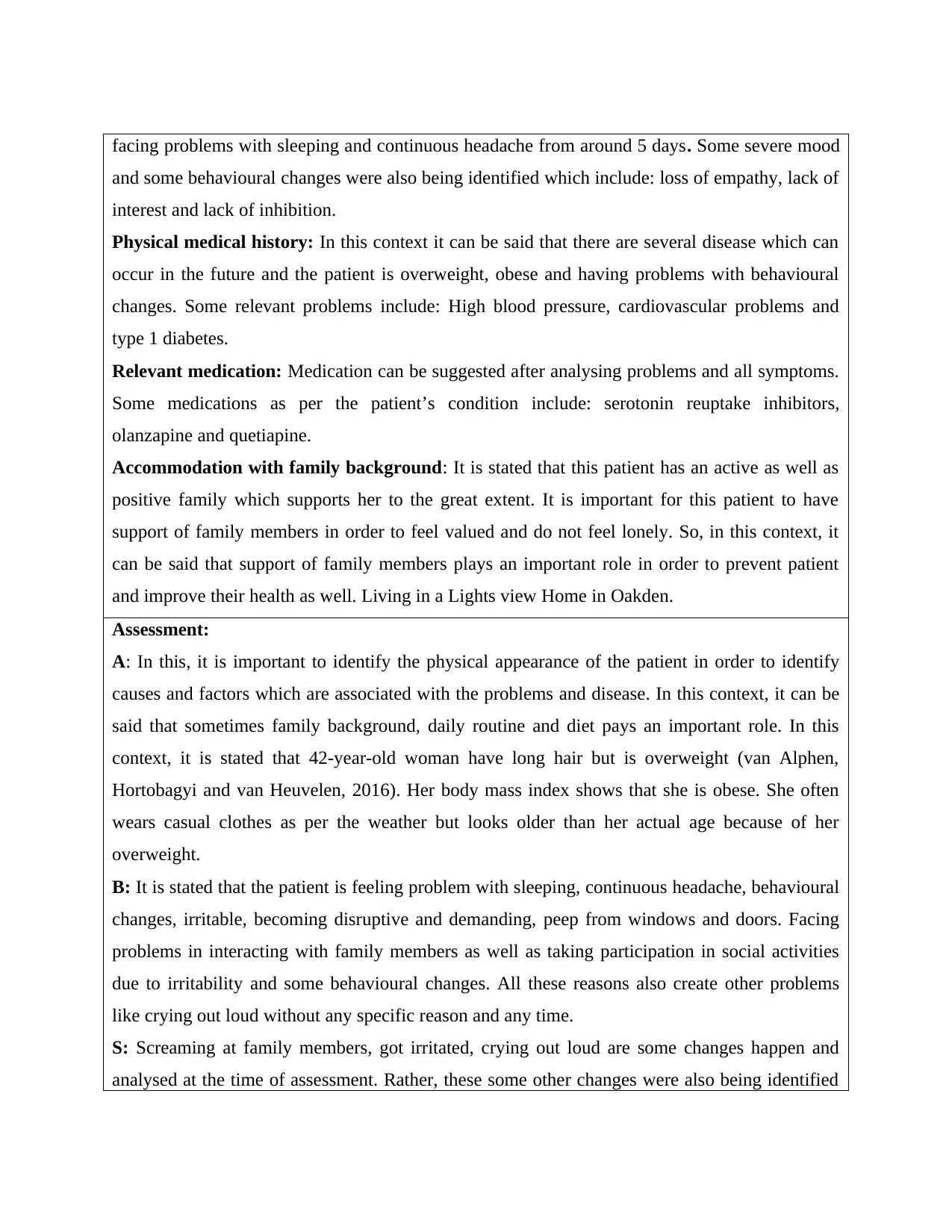
facing problems with sleeping and continuous headache from around 5 days. Some severe mood
and some behavioural changes were also being identified which include: loss of empathy, lack of
interest and lack of inhibition.
Physical medical history: In this context it can be said that there are several disease which can
occur in the future and the patient is overweight, obese and having problems with behavioural
changes. Some relevant problems include: High blood pressure, cardiovascular problems and
type 1 diabetes.
Relevant medication: Medication can be suggested after analysing problems and all symptoms.
Some medications as per the patient’s condition include: serotonin reuptake inhibitors,
olanzapine and quetiapine.
Accommodation with family background: It is stated that this patient has an active as well as
positive family which supports her to the great extent. It is important for this patient to have
support of family members in order to feel valued and do not feel lonely. So, in this context, it
can be said that support of family members plays an important role in order to prevent patient
and improve their health as well. Living in a Lights view Home in Oakden.
Assessment:
A: In this, it is important to identify the physical appearance of the patient in order to identify
causes and factors which are associated with the problems and disease. In this context, it can be
said that sometimes family background, daily routine and diet pays an important role. In this
context, it is stated that 42-year-old woman have long hair but is overweight (van Alphen,
Hortobagyi and van Heuvelen, 2016). Her body mass index shows that she is obese. She often
wears casual clothes as per the weather but looks older than her actual age because of her
overweight.
B: It is stated that the patient is feeling problem with sleeping, continuous headache, behavioural
changes, irritable, becoming disruptive and demanding, peep from windows and doors. Facing
problems in interacting with family members as well as taking participation in social activities
due to irritability and some behavioural changes. All these reasons also create other problems
like crying out loud without any specific reason and any time.
S: Screaming at family members, got irritated, crying out loud are some changes happen and
analysed at the time of assessment. Rather, these some other changes were also being identified
and some behavioural changes were also being identified which include: loss of empathy, lack of
interest and lack of inhibition.
Physical medical history: In this context it can be said that there are several disease which can
occur in the future and the patient is overweight, obese and having problems with behavioural
changes. Some relevant problems include: High blood pressure, cardiovascular problems and
type 1 diabetes.
Relevant medication: Medication can be suggested after analysing problems and all symptoms.
Some medications as per the patient’s condition include: serotonin reuptake inhibitors,
olanzapine and quetiapine.
Accommodation with family background: It is stated that this patient has an active as well as
positive family which supports her to the great extent. It is important for this patient to have
support of family members in order to feel valued and do not feel lonely. So, in this context, it
can be said that support of family members plays an important role in order to prevent patient
and improve their health as well. Living in a Lights view Home in Oakden.
Assessment:
A: In this, it is important to identify the physical appearance of the patient in order to identify
causes and factors which are associated with the problems and disease. In this context, it can be
said that sometimes family background, daily routine and diet pays an important role. In this
context, it is stated that 42-year-old woman have long hair but is overweight (van Alphen,
Hortobagyi and van Heuvelen, 2016). Her body mass index shows that she is obese. She often
wears casual clothes as per the weather but looks older than her actual age because of her
overweight.
B: It is stated that the patient is feeling problem with sleeping, continuous headache, behavioural
changes, irritable, becoming disruptive and demanding, peep from windows and doors. Facing
problems in interacting with family members as well as taking participation in social activities
due to irritability and some behavioural changes. All these reasons also create other problems
like crying out loud without any specific reason and any time.
S: Screaming at family members, got irritated, crying out loud are some changes happen and
analysed at the time of assessment. Rather, these some other changes were also being identified
Paraphrase This Document
Need a fresh take? Get an instant paraphrase of this document with our AI Paraphraser

in the assessment which includes:
Irritable, anger, muscle pain, weakness, inappropriate laughing and crying.
Clinical signs: It is important to ask some questions from family members in order to know the
intensity of the disease. So, some questions which can help in identifying intensity of the disease
include; whether the patient tried to suicide and risk of harming others?
Risks to self: After asking questions and analysing situations it is analysed that:
1) risk of self-neglect
2) Risk of having hypoglycaemia
3) Health deterioration
4) Rigidity
Risks to others
1) Poor coordination
2) Damaged property in anger
3) Screaming on others specially on family members without any reason and any time.
Recommendation
What are the specific recommendations for treatment, medications, other team involvement?
Recommendations for ongoing care.
PLAN
-To have the admitting to PICU under the IT02 for the level of immediate assessment along with
care to have stabilisation of more open wars
-ITO have the level 2 which is being reviewed within 24 hours by the usage of psychiatrists
along with authorised level of medical printanier along with being confirmed or revoked.
-Monitor ETOH and Meth withdrawals if applicable.
-Medication review (mood stabilisers).
-To have the proper level of administration by regular level of medication along with charted
PNR which is been indicated.
-To have the monitoring of adverse effects which can be rested to significant medication
changes.
-To have continue monitoring state by stabilizing more level of improvement in the mental
Irritable, anger, muscle pain, weakness, inappropriate laughing and crying.
Clinical signs: It is important to ask some questions from family members in order to know the
intensity of the disease. So, some questions which can help in identifying intensity of the disease
include; whether the patient tried to suicide and risk of harming others?
Risks to self: After asking questions and analysing situations it is analysed that:
1) risk of self-neglect
2) Risk of having hypoglycaemia
3) Health deterioration
4) Rigidity
Risks to others
1) Poor coordination
2) Damaged property in anger
3) Screaming on others specially on family members without any reason and any time.
Recommendation
What are the specific recommendations for treatment, medications, other team involvement?
Recommendations for ongoing care.
PLAN
-To have the admitting to PICU under the IT02 for the level of immediate assessment along with
care to have stabilisation of more open wars
-ITO have the level 2 which is being reviewed within 24 hours by the usage of psychiatrists
along with authorised level of medical printanier along with being confirmed or revoked.
-Monitor ETOH and Meth withdrawals if applicable.
-Medication review (mood stabilisers).
-To have the proper level of administration by regular level of medication along with charted
PNR which is been indicated.
-To have the monitoring of adverse effects which can be rested to significant medication
changes.
-To have continue monitoring state by stabilizing more level of improvement in the mental

health.
-By having the daily level of risk assessment by having the physio R/V by maintaining more
level of visual observation per ward protocol.
-To have vital signs by having admission which are clinically indicated by reviewing the treating
the Psychiatric treating team
Recommendation
-referral to have the occupation therapist which have the diversional therapy.
-To have the referral to be the diabetic educator which is regarding the regarding type1 diabetes
management. Diabetes can also interfere and contribute to behaviours if not well managed.
-To have the comprehensive psychological assessments which is helpful in monitoring physical
observation in daily basis.
-Help to have allowing the 1:1 tome to have the assessing mental state along the risk assent and
document.
-This is to provide therapeutic coping strategies, explore possible meaningful activity for
engagement.
-There should be provide education in sleep, hygiene and medication compliance including diet
and exercise
Assessment 3
Part A
Patients’ background of case study: it is a case study of a 42 year old female who presented
with a 6 months of diffuse headache of moderate intensity. There are some other problems also
represented which include; mild weakness, memory decline, overweight, some behavioural
changes include: crying and laughing any time without any reason, constipation and obesity. In
addition, it is also important to identify her physical appearance as how she lives, what she wears
and what she eats and her daily routine activities (Zhang and et.al., 2017). So, in this context, it is
stated that she looks older than her age and it is because she is overweight and obese. Her body
mass index is high. She has long hair but now due to depression, headache and some behavioural
-By having the daily level of risk assessment by having the physio R/V by maintaining more
level of visual observation per ward protocol.
-To have vital signs by having admission which are clinically indicated by reviewing the treating
the Psychiatric treating team
Recommendation
-referral to have the occupation therapist which have the diversional therapy.
-To have the referral to be the diabetic educator which is regarding the regarding type1 diabetes
management. Diabetes can also interfere and contribute to behaviours if not well managed.
-To have the comprehensive psychological assessments which is helpful in monitoring physical
observation in daily basis.
-Help to have allowing the 1:1 tome to have the assessing mental state along the risk assent and
document.
-This is to provide therapeutic coping strategies, explore possible meaningful activity for
engagement.
-There should be provide education in sleep, hygiene and medication compliance including diet
and exercise
Assessment 3
Part A
Patients’ background of case study: it is a case study of a 42 year old female who presented
with a 6 months of diffuse headache of moderate intensity. There are some other problems also
represented which include; mild weakness, memory decline, overweight, some behavioural
changes include: crying and laughing any time without any reason, constipation and obesity. In
addition, it is also important to identify her physical appearance as how she lives, what she wears
and what she eats and her daily routine activities (Zhang and et.al., 2017). So, in this context, it is
stated that she looks older than her age and it is because she is overweight and obese. Her body
mass index is high. She has long hair but now due to depression, headache and some behavioural
⊘ This is a preview!⊘
Do you want full access?
Subscribe today to unlock all pages.

Trusted by 1+ million students worldwide
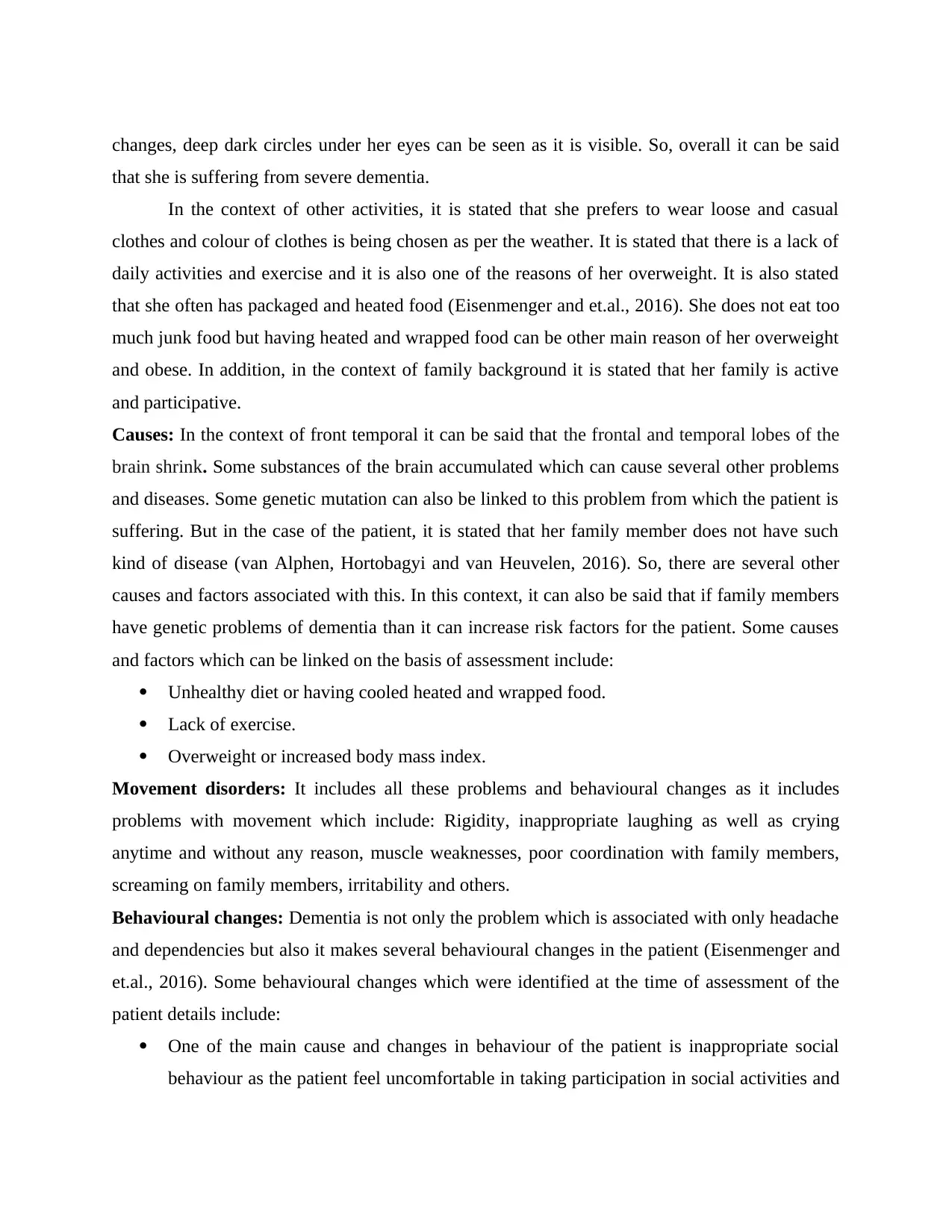
changes, deep dark circles under her eyes can be seen as it is visible. So, overall it can be said
that she is suffering from severe dementia.
In the context of other activities, it is stated that she prefers to wear loose and casual
clothes and colour of clothes is being chosen as per the weather. It is stated that there is a lack of
daily activities and exercise and it is also one of the reasons of her overweight. It is also stated
that she often has packaged and heated food (Eisenmenger and et.al., 2016). She does not eat too
much junk food but having heated and wrapped food can be other main reason of her overweight
and obese. In addition, in the context of family background it is stated that her family is active
and participative.
Causes: In the context of front temporal it can be said that the frontal and temporal lobes of the
brain shrink. Some substances of the brain accumulated which can cause several other problems
and diseases. Some genetic mutation can also be linked to this problem from which the patient is
suffering. But in the case of the patient, it is stated that her family member does not have such
kind of disease (van Alphen, Hortobagyi and van Heuvelen, 2016). So, there are several other
causes and factors associated with this. In this context, it can also be said that if family members
have genetic problems of dementia than it can increase risk factors for the patient. Some causes
and factors which can be linked on the basis of assessment include:
Unhealthy diet or having cooled heated and wrapped food.
Lack of exercise.
Overweight or increased body mass index.
Movement disorders: It includes all these problems and behavioural changes as it includes
problems with movement which include: Rigidity, inappropriate laughing as well as crying
anytime and without any reason, muscle weaknesses, poor coordination with family members,
screaming on family members, irritability and others.
Behavioural changes: Dementia is not only the problem which is associated with only headache
and dependencies but also it makes several behavioural changes in the patient (Eisenmenger and
et.al., 2016). Some behavioural changes which were identified at the time of assessment of the
patient details include:
One of the main cause and changes in behaviour of the patient is inappropriate social
behaviour as the patient feel uncomfortable in taking participation in social activities and
that she is suffering from severe dementia.
In the context of other activities, it is stated that she prefers to wear loose and casual
clothes and colour of clothes is being chosen as per the weather. It is stated that there is a lack of
daily activities and exercise and it is also one of the reasons of her overweight. It is also stated
that she often has packaged and heated food (Eisenmenger and et.al., 2016). She does not eat too
much junk food but having heated and wrapped food can be other main reason of her overweight
and obese. In addition, in the context of family background it is stated that her family is active
and participative.
Causes: In the context of front temporal it can be said that the frontal and temporal lobes of the
brain shrink. Some substances of the brain accumulated which can cause several other problems
and diseases. Some genetic mutation can also be linked to this problem from which the patient is
suffering. But in the case of the patient, it is stated that her family member does not have such
kind of disease (van Alphen, Hortobagyi and van Heuvelen, 2016). So, there are several other
causes and factors associated with this. In this context, it can also be said that if family members
have genetic problems of dementia than it can increase risk factors for the patient. Some causes
and factors which can be linked on the basis of assessment include:
Unhealthy diet or having cooled heated and wrapped food.
Lack of exercise.
Overweight or increased body mass index.
Movement disorders: It includes all these problems and behavioural changes as it includes
problems with movement which include: Rigidity, inappropriate laughing as well as crying
anytime and without any reason, muscle weaknesses, poor coordination with family members,
screaming on family members, irritability and others.
Behavioural changes: Dementia is not only the problem which is associated with only headache
and dependencies but also it makes several behavioural changes in the patient (Eisenmenger and
et.al., 2016). Some behavioural changes which were identified at the time of assessment of the
patient details include:
One of the main cause and changes in behaviour of the patient is inappropriate social
behaviour as the patient feel uncomfortable in taking participation in social activities and
Paraphrase This Document
Need a fresh take? Get an instant paraphrase of this document with our AI Paraphraser
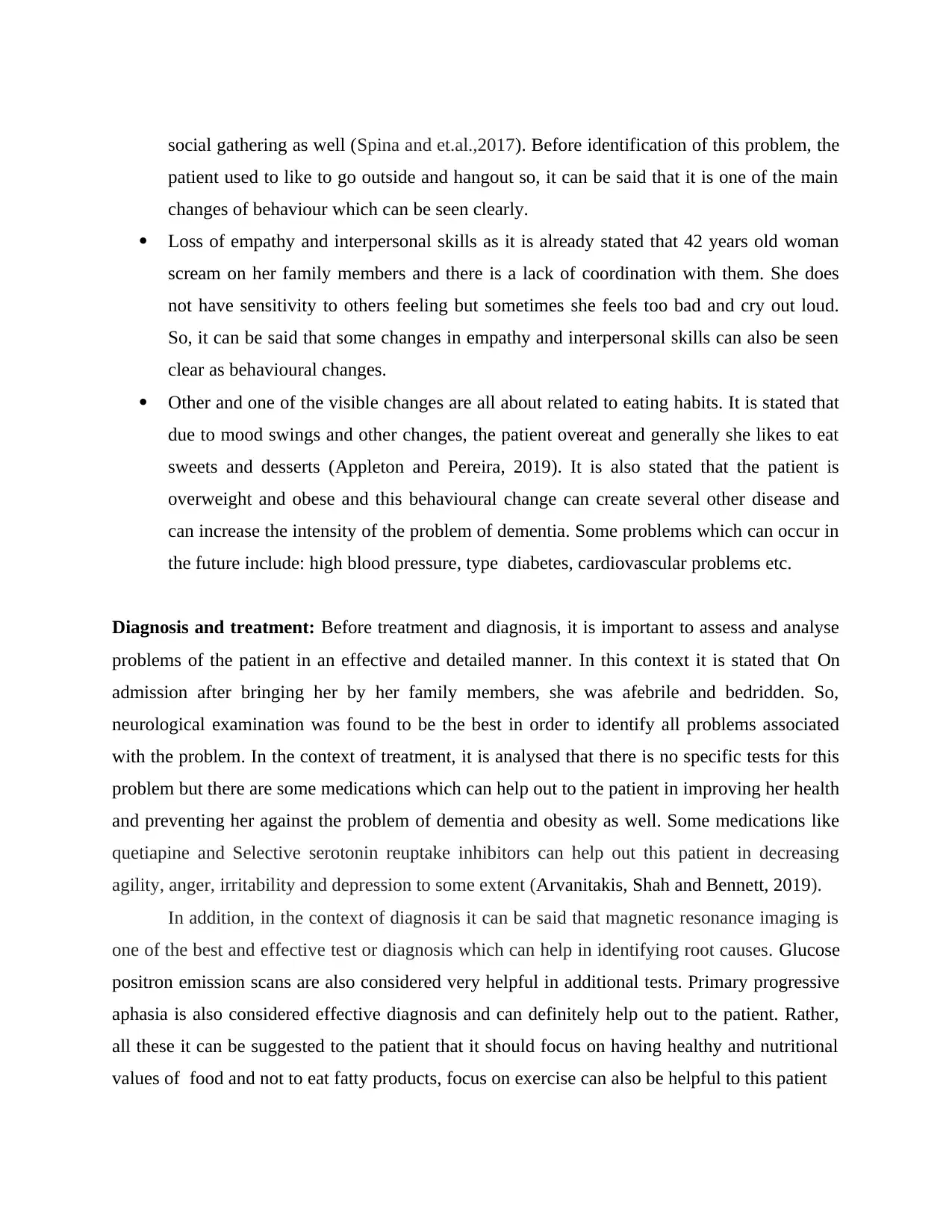
social gathering as well (Spina and et.al.,2017). Before identification of this problem, the
patient used to like to go outside and hangout so, it can be said that it is one of the main
changes of behaviour which can be seen clearly.
Loss of empathy and interpersonal skills as it is already stated that 42 years old woman
scream on her family members and there is a lack of coordination with them. She does
not have sensitivity to others feeling but sometimes she feels too bad and cry out loud.
So, it can be said that some changes in empathy and interpersonal skills can also be seen
clear as behavioural changes.
Other and one of the visible changes are all about related to eating habits. It is stated that
due to mood swings and other changes, the patient overeat and generally she likes to eat
sweets and desserts (Appleton and Pereira, 2019). It is also stated that the patient is
overweight and obese and this behavioural change can create several other disease and
can increase the intensity of the problem of dementia. Some problems which can occur in
the future include: high blood pressure, type diabetes, cardiovascular problems etc.
Diagnosis and treatment: Before treatment and diagnosis, it is important to assess and analyse
problems of the patient in an effective and detailed manner. In this context it is stated that On
admission after bringing her by her family members, she was afebrile and bedridden. So,
neurological examination was found to be the best in order to identify all problems associated
with the problem. In the context of treatment, it is analysed that there is no specific tests for this
problem but there are some medications which can help out to the patient in improving her health
and preventing her against the problem of dementia and obesity as well. Some medications like
quetiapine and Selective serotonin reuptake inhibitors can help out this patient in decreasing
agility, anger, irritability and depression to some extent (Arvanitakis, Shah and Bennett, 2019).
In addition, in the context of diagnosis it can be said that magnetic resonance imaging is
one of the best and effective test or diagnosis which can help in identifying root causes. Glucose
positron emission scans are also considered very helpful in additional tests. Primary progressive
aphasia is also considered effective diagnosis and can definitely help out to the patient. Rather,
all these it can be suggested to the patient that it should focus on having healthy and nutritional
values of food and not to eat fatty products, focus on exercise can also be helpful to this patient
patient used to like to go outside and hangout so, it can be said that it is one of the main
changes of behaviour which can be seen clearly.
Loss of empathy and interpersonal skills as it is already stated that 42 years old woman
scream on her family members and there is a lack of coordination with them. She does
not have sensitivity to others feeling but sometimes she feels too bad and cry out loud.
So, it can be said that some changes in empathy and interpersonal skills can also be seen
clear as behavioural changes.
Other and one of the visible changes are all about related to eating habits. It is stated that
due to mood swings and other changes, the patient overeat and generally she likes to eat
sweets and desserts (Appleton and Pereira, 2019). It is also stated that the patient is
overweight and obese and this behavioural change can create several other disease and
can increase the intensity of the problem of dementia. Some problems which can occur in
the future include: high blood pressure, type diabetes, cardiovascular problems etc.
Diagnosis and treatment: Before treatment and diagnosis, it is important to assess and analyse
problems of the patient in an effective and detailed manner. In this context it is stated that On
admission after bringing her by her family members, she was afebrile and bedridden. So,
neurological examination was found to be the best in order to identify all problems associated
with the problem. In the context of treatment, it is analysed that there is no specific tests for this
problem but there are some medications which can help out to the patient in improving her health
and preventing her against the problem of dementia and obesity as well. Some medications like
quetiapine and Selective serotonin reuptake inhibitors can help out this patient in decreasing
agility, anger, irritability and depression to some extent (Arvanitakis, Shah and Bennett, 2019).
In addition, in the context of diagnosis it can be said that magnetic resonance imaging is
one of the best and effective test or diagnosis which can help in identifying root causes. Glucose
positron emission scans are also considered very helpful in additional tests. Primary progressive
aphasia is also considered effective diagnosis and can definitely help out to the patient. Rather,
all these it can be suggested to the patient that it should focus on having healthy and nutritional
values of food and not to eat fatty products, focus on exercise can also be helpful to this patient
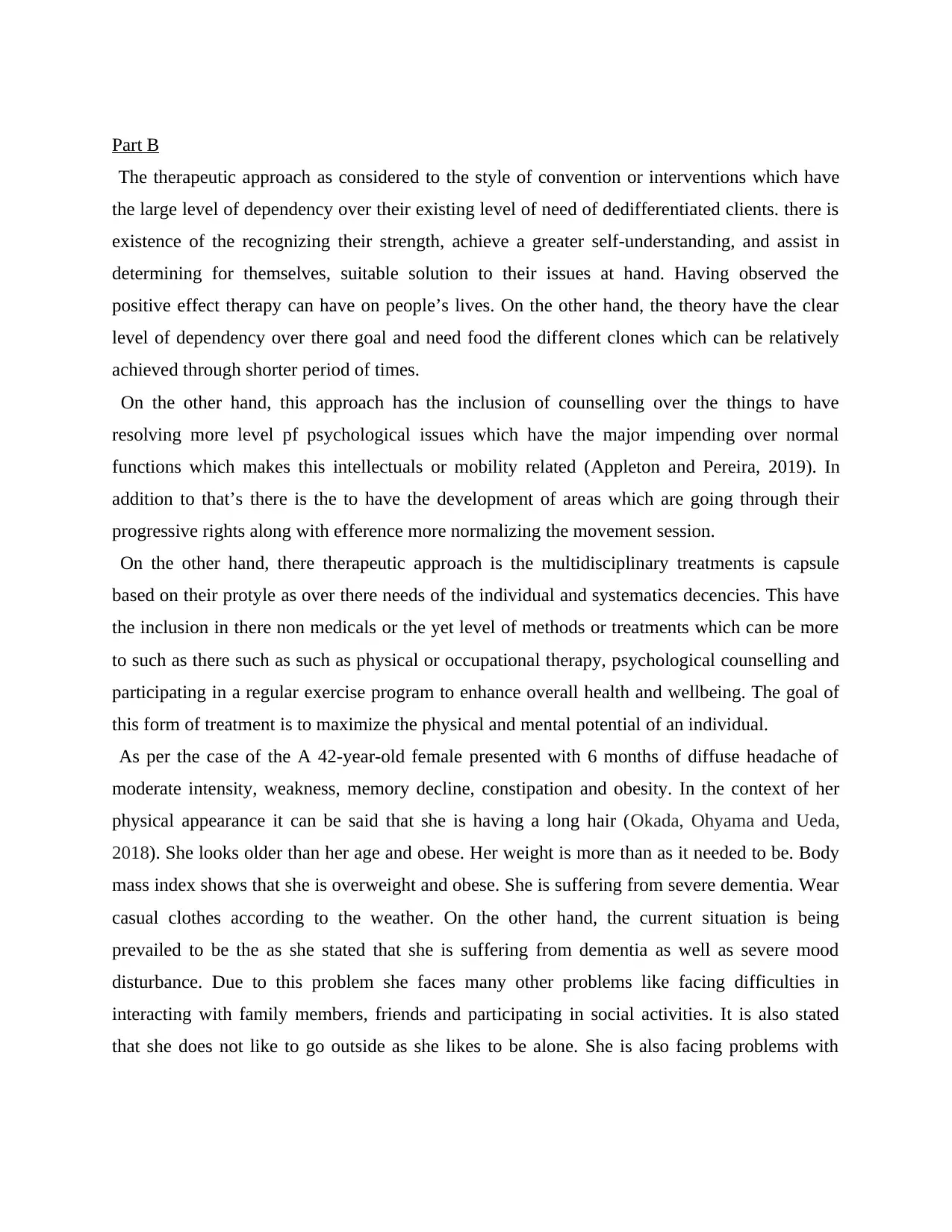
Part B
The therapeutic approach as considered to the style of convention or interventions which have
the large level of dependency over their existing level of need of dedifferentiated clients. there is
existence of the recognizing their strength, achieve a greater self-understanding, and assist in
determining for themselves, suitable solution to their issues at hand. Having observed the
positive effect therapy can have on people’s lives. On the other hand, the theory have the clear
level of dependency over there goal and need food the different clones which can be relatively
achieved through shorter period of times.
On the other hand, this approach has the inclusion of counselling over the things to have
resolving more level pf psychological issues which have the major impending over normal
functions which makes this intellectuals or mobility related (Appleton and Pereira, 2019). In
addition to that’s there is the to have the development of areas which are going through their
progressive rights along with efference more normalizing the movement session.
On the other hand, there therapeutic approach is the multidisciplinary treatments is capsule
based on their protyle as over there needs of the individual and systematics decencies. This have
the inclusion in there non medicals or the yet level of methods or treatments which can be more
to such as there such as such as physical or occupational therapy, psychological counselling and
participating in a regular exercise program to enhance overall health and wellbeing. The goal of
this form of treatment is to maximize the physical and mental potential of an individual.
As per the case of the A 42-year-old female presented with 6 months of diffuse headache of
moderate intensity, weakness, memory decline, constipation and obesity. In the context of her
physical appearance it can be said that she is having a long hair (Okada, Ohyama and Ueda,
2018). She looks older than her age and obese. Her weight is more than as it needed to be. Body
mass index shows that she is overweight and obese. She is suffering from severe dementia. Wear
casual clothes according to the weather. On the other hand, the current situation is being
prevailed to be the as she stated that she is suffering from dementia as well as severe mood
disturbance. Due to this problem she faces many other problems like facing difficulties in
interacting with family members, friends and participating in social activities. It is also stated
that she does not like to go outside as she likes to be alone. She is also facing problems with
The therapeutic approach as considered to the style of convention or interventions which have
the large level of dependency over their existing level of need of dedifferentiated clients. there is
existence of the recognizing their strength, achieve a greater self-understanding, and assist in
determining for themselves, suitable solution to their issues at hand. Having observed the
positive effect therapy can have on people’s lives. On the other hand, the theory have the clear
level of dependency over there goal and need food the different clones which can be relatively
achieved through shorter period of times.
On the other hand, this approach has the inclusion of counselling over the things to have
resolving more level pf psychological issues which have the major impending over normal
functions which makes this intellectuals or mobility related (Appleton and Pereira, 2019). In
addition to that’s there is the to have the development of areas which are going through their
progressive rights along with efference more normalizing the movement session.
On the other hand, there therapeutic approach is the multidisciplinary treatments is capsule
based on their protyle as over there needs of the individual and systematics decencies. This have
the inclusion in there non medicals or the yet level of methods or treatments which can be more
to such as there such as such as physical or occupational therapy, psychological counselling and
participating in a regular exercise program to enhance overall health and wellbeing. The goal of
this form of treatment is to maximize the physical and mental potential of an individual.
As per the case of the A 42-year-old female presented with 6 months of diffuse headache of
moderate intensity, weakness, memory decline, constipation and obesity. In the context of her
physical appearance it can be said that she is having a long hair (Okada, Ohyama and Ueda,
2018). She looks older than her age and obese. Her weight is more than as it needed to be. Body
mass index shows that she is overweight and obese. She is suffering from severe dementia. Wear
casual clothes according to the weather. On the other hand, the current situation is being
prevailed to be the as she stated that she is suffering from dementia as well as severe mood
disturbance. Due to this problem she faces many other problems like facing difficulties in
interacting with family members, friends and participating in social activities. It is also stated
that she does not like to go outside as she likes to be alone. She is also facing problems with
⊘ This is a preview!⊘
Do you want full access?
Subscribe today to unlock all pages.

Trusted by 1+ million students worldwide
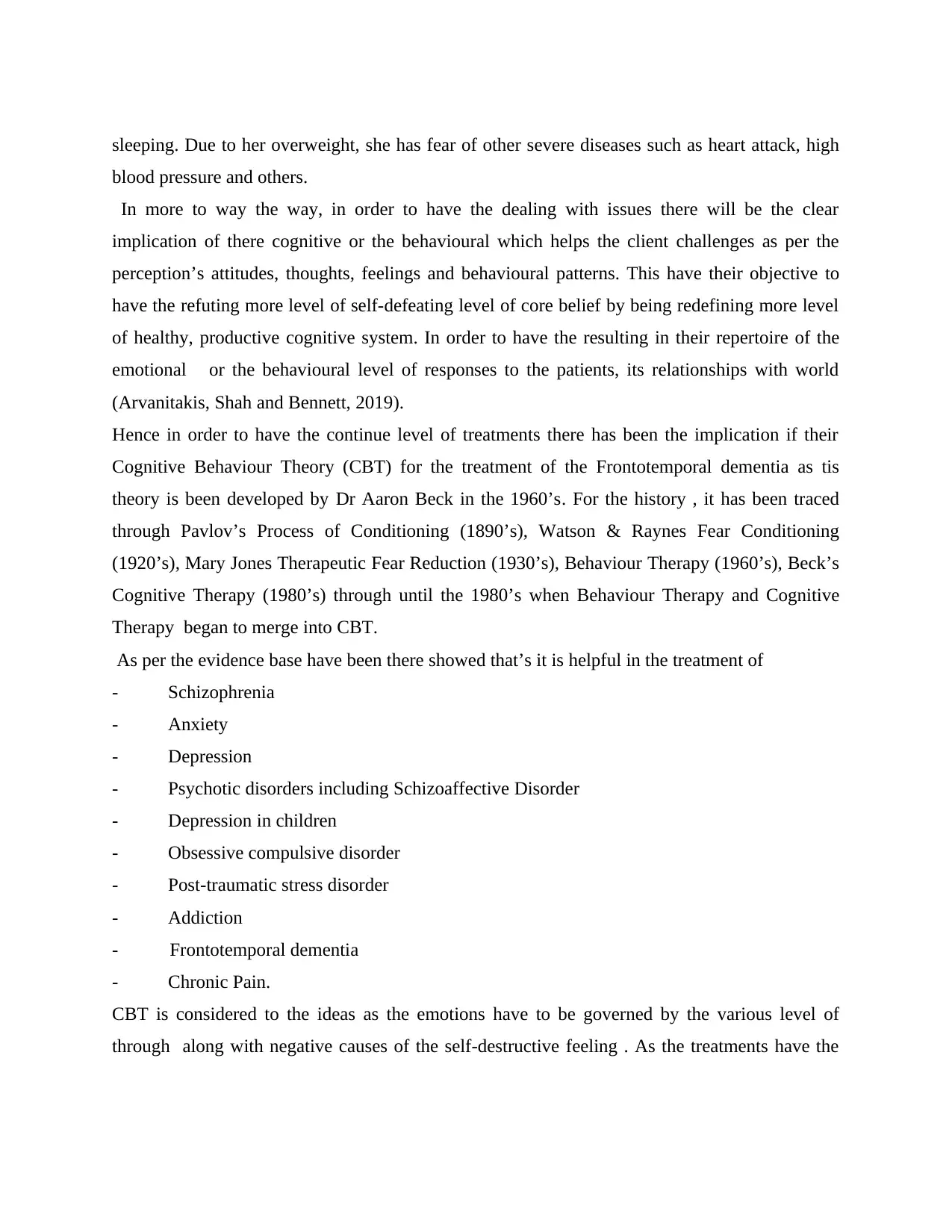
sleeping. Due to her overweight, she has fear of other severe diseases such as heart attack, high
blood pressure and others.
In more to way the way, in order to have the dealing with issues there will be the clear
implication of there cognitive or the behavioural which helps the client challenges as per the
perception’s attitudes, thoughts, feelings and behavioural patterns. This have their objective to
have the refuting more level of self-defeating level of core belief by being redefining more level
of healthy, productive cognitive system. In order to have the resulting in their repertoire of the
emotional or the behavioural level of responses to the patients, its relationships with world
(Arvanitakis, Shah and Bennett, 2019).
Hence in order to have the continue level of treatments there has been the implication if their
Cognitive Behaviour Theory (CBT) for the treatment of the Frontotemporal dementia as tis
theory is been developed by Dr Aaron Beck in the 1960’s. For the history , it has been traced
through Pavlov’s Process of Conditioning (1890’s), Watson & Raynes Fear Conditioning
(1920’s), Mary Jones Therapeutic Fear Reduction (1930’s), Behaviour Therapy (1960’s), Beck’s
Cognitive Therapy (1980’s) through until the 1980’s when Behaviour Therapy and Cognitive
Therapy began to merge into CBT.
As per the evidence base have been there showed that’s it is helpful in the treatment of
- Schizophrenia
- Anxiety
- Depression
- Psychotic disorders including Schizoaffective Disorder
- Depression in children
- Obsessive compulsive disorder
- Post-traumatic stress disorder
- Addiction
- Frontotemporal dementia
- Chronic Pain.
CBT is considered to the ideas as the emotions have to be governed by the various level of
through along with negative causes of the self-destructive feeling . As the treatments have the
blood pressure and others.
In more to way the way, in order to have the dealing with issues there will be the clear
implication of there cognitive or the behavioural which helps the client challenges as per the
perception’s attitudes, thoughts, feelings and behavioural patterns. This have their objective to
have the refuting more level of self-defeating level of core belief by being redefining more level
of healthy, productive cognitive system. In order to have the resulting in their repertoire of the
emotional or the behavioural level of responses to the patients, its relationships with world
(Arvanitakis, Shah and Bennett, 2019).
Hence in order to have the continue level of treatments there has been the implication if their
Cognitive Behaviour Theory (CBT) for the treatment of the Frontotemporal dementia as tis
theory is been developed by Dr Aaron Beck in the 1960’s. For the history , it has been traced
through Pavlov’s Process of Conditioning (1890’s), Watson & Raynes Fear Conditioning
(1920’s), Mary Jones Therapeutic Fear Reduction (1930’s), Behaviour Therapy (1960’s), Beck’s
Cognitive Therapy (1980’s) through until the 1980’s when Behaviour Therapy and Cognitive
Therapy began to merge into CBT.
As per the evidence base have been there showed that’s it is helpful in the treatment of
- Schizophrenia
- Anxiety
- Depression
- Psychotic disorders including Schizoaffective Disorder
- Depression in children
- Obsessive compulsive disorder
- Post-traumatic stress disorder
- Addiction
- Frontotemporal dementia
- Chronic Pain.
CBT is considered to the ideas as the emotions have to be governed by the various level of
through along with negative causes of the self-destructive feeling . As the treatments have the
Paraphrase This Document
Need a fresh take? Get an instant paraphrase of this document with our AI Paraphraser
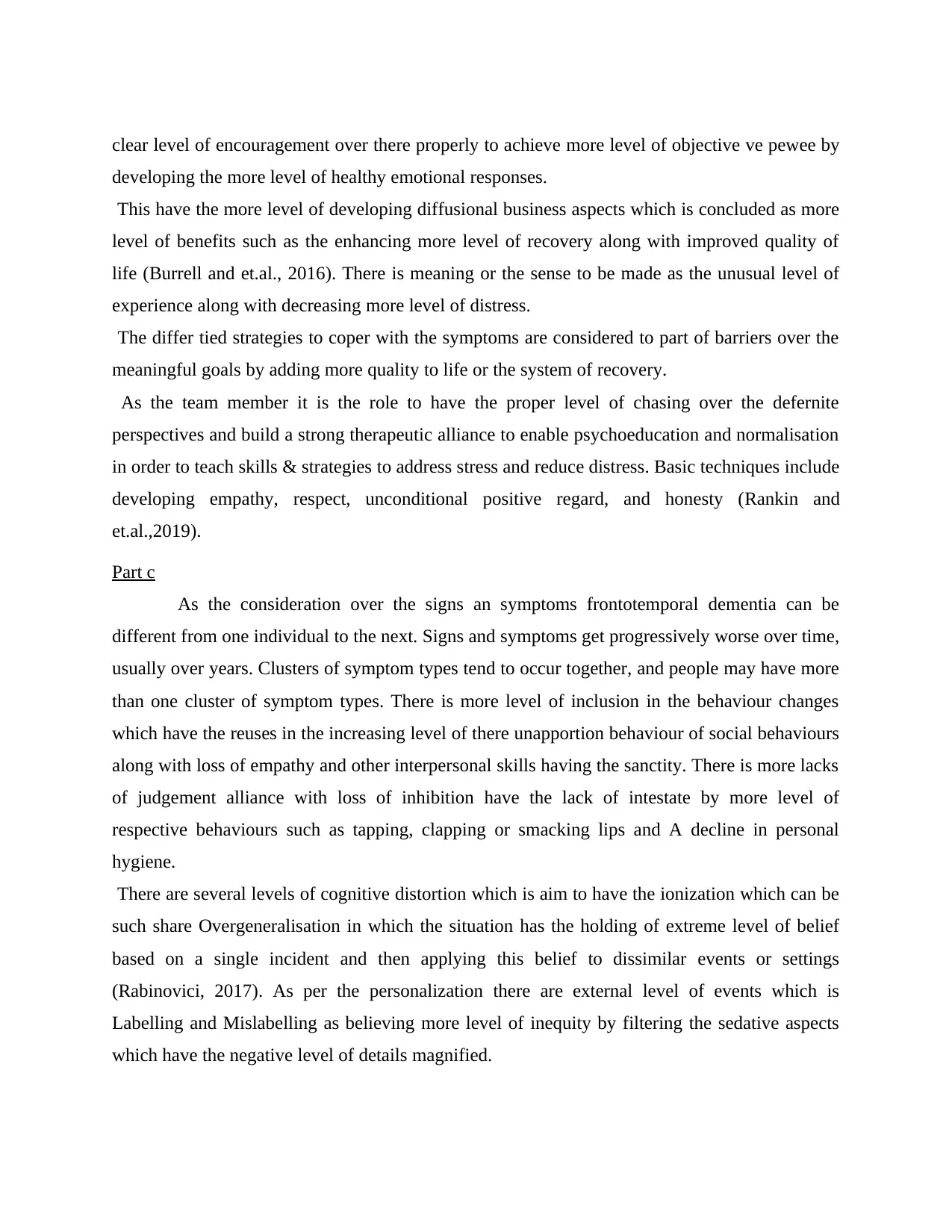
clear level of encouragement over there properly to achieve more level of objective ve pewee by
developing the more level of healthy emotional responses.
This have the more level of developing diffusional business aspects which is concluded as more
level of benefits such as the enhancing more level of recovery along with improved quality of
life (Burrell and et.al., 2016). There is meaning or the sense to be made as the unusual level of
experience along with decreasing more level of distress.
The differ tied strategies to coper with the symptoms are considered to part of barriers over the
meaningful goals by adding more quality to life or the system of recovery.
As the team member it is the role to have the proper level of chasing over the defernite
perspectives and build a strong therapeutic alliance to enable psychoeducation and normalisation
in order to teach skills & strategies to address stress and reduce distress. Basic techniques include
developing empathy, respect, unconditional positive regard, and honesty (Rankin and
et.al.,2019).
Part c
As the consideration over the signs an symptoms frontotemporal dementia can be
different from one individual to the next. Signs and symptoms get progressively worse over time,
usually over years. Clusters of symptom types tend to occur together, and people may have more
than one cluster of symptom types. There is more level of inclusion in the behaviour changes
which have the reuses in the increasing level of there unapportion behaviour of social behaviours
along with loss of empathy and other interpersonal skills having the sanctity. There is more lacks
of judgement alliance with loss of inhibition have the lack of intestate by more level of
respective behaviours such as tapping, clapping or smacking lips and A decline in personal
hygiene.
There are several levels of cognitive distortion which is aim to have the ionization which can be
such share Overgeneralisation in which the situation has the holding of extreme level of belief
based on a single incident and then applying this belief to dissimilar events or settings
(Rabinovici, 2017). As per the personalization there are external level of events which is
Labelling and Mislabelling as believing more level of inequity by filtering the sedative aspects
which have the negative level of details magnified.
developing the more level of healthy emotional responses.
This have the more level of developing diffusional business aspects which is concluded as more
level of benefits such as the enhancing more level of recovery along with improved quality of
life (Burrell and et.al., 2016). There is meaning or the sense to be made as the unusual level of
experience along with decreasing more level of distress.
The differ tied strategies to coper with the symptoms are considered to part of barriers over the
meaningful goals by adding more quality to life or the system of recovery.
As the team member it is the role to have the proper level of chasing over the defernite
perspectives and build a strong therapeutic alliance to enable psychoeducation and normalisation
in order to teach skills & strategies to address stress and reduce distress. Basic techniques include
developing empathy, respect, unconditional positive regard, and honesty (Rankin and
et.al.,2019).
Part c
As the consideration over the signs an symptoms frontotemporal dementia can be
different from one individual to the next. Signs and symptoms get progressively worse over time,
usually over years. Clusters of symptom types tend to occur together, and people may have more
than one cluster of symptom types. There is more level of inclusion in the behaviour changes
which have the reuses in the increasing level of there unapportion behaviour of social behaviours
along with loss of empathy and other interpersonal skills having the sanctity. There is more lacks
of judgement alliance with loss of inhibition have the lack of intestate by more level of
respective behaviours such as tapping, clapping or smacking lips and A decline in personal
hygiene.
There are several levels of cognitive distortion which is aim to have the ionization which can be
such share Overgeneralisation in which the situation has the holding of extreme level of belief
based on a single incident and then applying this belief to dissimilar events or settings
(Rabinovici, 2017). As per the personalization there are external level of events which is
Labelling and Mislabelling as believing more level of inequity by filtering the sedative aspects
which have the negative level of details magnified.
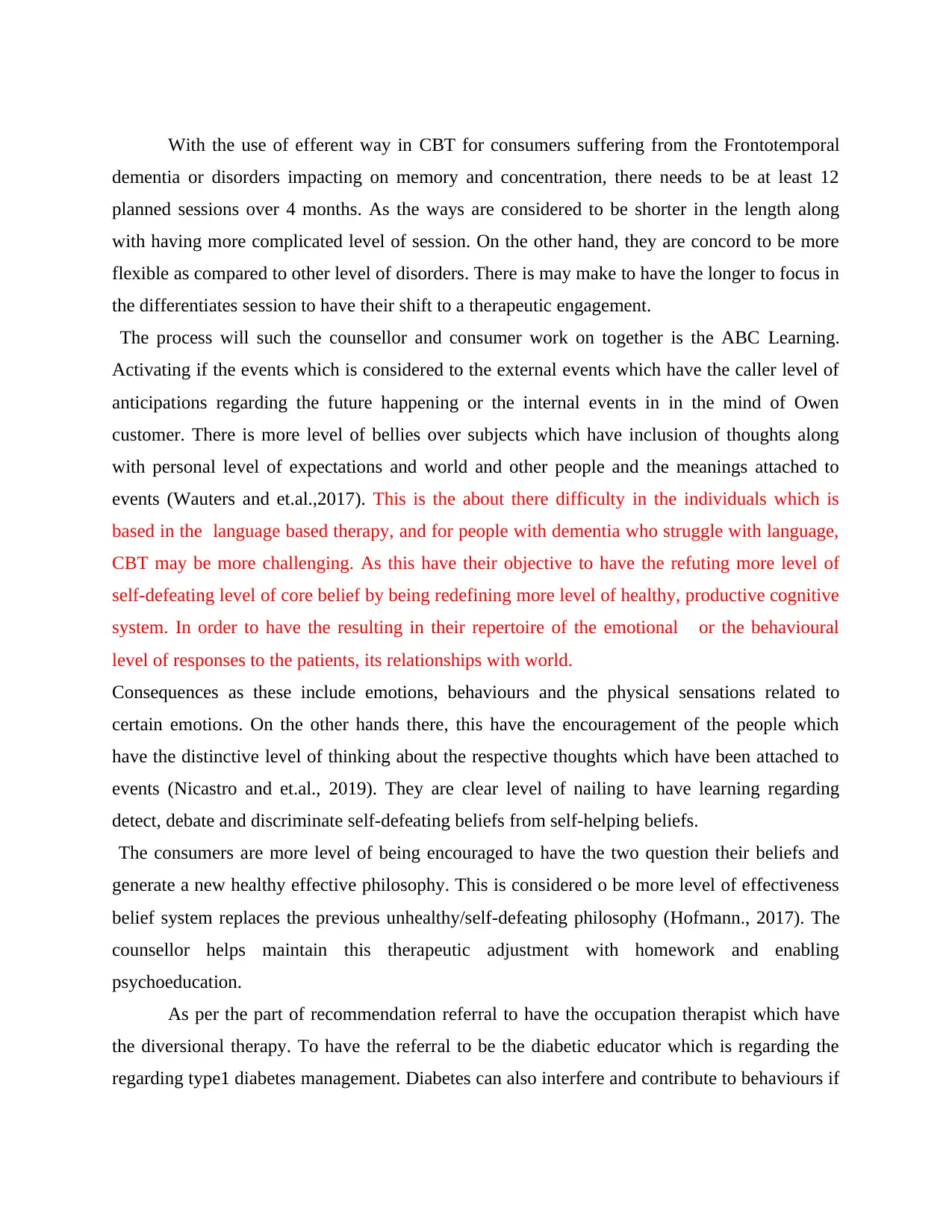
With the use of efferent way in CBT for consumers suffering from the Frontotemporal
dementia or disorders impacting on memory and concentration, there needs to be at least 12
planned sessions over 4 months. As the ways are considered to be shorter in the length along
with having more complicated level of session. On the other hand, they are concord to be more
flexible as compared to other level of disorders. There is may make to have the longer to focus in
the differentiates session to have their shift to a therapeutic engagement.
The process will such the counsellor and consumer work on together is the ABC Learning.
Activating if the events which is considered to the external events which have the caller level of
anticipations regarding the future happening or the internal events in in the mind of Owen
customer. There is more level of bellies over subjects which have inclusion of thoughts along
with personal level of expectations and world and other people and the meanings attached to
events (Wauters and et.al.,2017). This is the about there difficulty in the individuals which is
based in the language based therapy, and for people with dementia who struggle with language,
CBT may be more challenging. As this have their objective to have the refuting more level of
self-defeating level of core belief by being redefining more level of healthy, productive cognitive
system. In order to have the resulting in their repertoire of the emotional or the behavioural
level of responses to the patients, its relationships with world.
Consequences as these include emotions, behaviours and the physical sensations related to
certain emotions. On the other hands there, this have the encouragement of the people which
have the distinctive level of thinking about the respective thoughts which have been attached to
events (Nicastro and et.al., 2019). They are clear level of nailing to have learning regarding
detect, debate and discriminate self-defeating beliefs from self-helping beliefs.
The consumers are more level of being encouraged to have the two question their beliefs and
generate a new healthy effective philosophy. This is considered o be more level of effectiveness
belief system replaces the previous unhealthy/self-defeating philosophy (Hofmann., 2017). The
counsellor helps maintain this therapeutic adjustment with homework and enabling
psychoeducation.
As per the part of recommendation referral to have the occupation therapist which have
the diversional therapy. To have the referral to be the diabetic educator which is regarding the
regarding type1 diabetes management. Diabetes can also interfere and contribute to behaviours if
dementia or disorders impacting on memory and concentration, there needs to be at least 12
planned sessions over 4 months. As the ways are considered to be shorter in the length along
with having more complicated level of session. On the other hand, they are concord to be more
flexible as compared to other level of disorders. There is may make to have the longer to focus in
the differentiates session to have their shift to a therapeutic engagement.
The process will such the counsellor and consumer work on together is the ABC Learning.
Activating if the events which is considered to the external events which have the caller level of
anticipations regarding the future happening or the internal events in in the mind of Owen
customer. There is more level of bellies over subjects which have inclusion of thoughts along
with personal level of expectations and world and other people and the meanings attached to
events (Wauters and et.al.,2017). This is the about there difficulty in the individuals which is
based in the language based therapy, and for people with dementia who struggle with language,
CBT may be more challenging. As this have their objective to have the refuting more level of
self-defeating level of core belief by being redefining more level of healthy, productive cognitive
system. In order to have the resulting in their repertoire of the emotional or the behavioural
level of responses to the patients, its relationships with world.
Consequences as these include emotions, behaviours and the physical sensations related to
certain emotions. On the other hands there, this have the encouragement of the people which
have the distinctive level of thinking about the respective thoughts which have been attached to
events (Nicastro and et.al., 2019). They are clear level of nailing to have learning regarding
detect, debate and discriminate self-defeating beliefs from self-helping beliefs.
The consumers are more level of being encouraged to have the two question their beliefs and
generate a new healthy effective philosophy. This is considered o be more level of effectiveness
belief system replaces the previous unhealthy/self-defeating philosophy (Hofmann., 2017). The
counsellor helps maintain this therapeutic adjustment with homework and enabling
psychoeducation.
As per the part of recommendation referral to have the occupation therapist which have
the diversional therapy. To have the referral to be the diabetic educator which is regarding the
regarding type1 diabetes management. Diabetes can also interfere and contribute to behaviours if
⊘ This is a preview!⊘
Do you want full access?
Subscribe today to unlock all pages.

Trusted by 1+ million students worldwide
1 out of 16
Related Documents
Your All-in-One AI-Powered Toolkit for Academic Success.
+13062052269
info@desklib.com
Available 24*7 on WhatsApp / Email
![[object Object]](/_next/static/media/star-bottom.7253800d.svg)
Unlock your academic potential
Copyright © 2020–2025 A2Z Services. All Rights Reserved. Developed and managed by ZUCOL.





